#dungeon master's guide 5e
Explore tagged Tumblr posts
Text
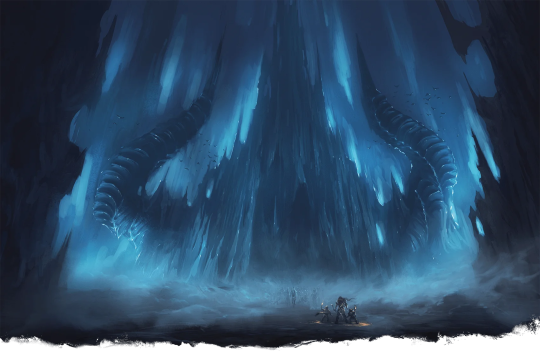
Shadowfell
Art for Dunge Master's Guide 5e
Art by Julian Kok
69 notes
·
View notes
Text
Level Up Your Combat Encounters with These 3 Resources
You can’t always prepare for those boosts in power the players get at higher levels or with magic items. So for that, I turn to the following resources to provide lair actions, bloodied actions, and legendary actions for CRs of all types.
We can all agree that as 5e characters level up it can become more difficult to challenge them to combat. There are many dials that the base 5e game provides that can help provide a variety of difficulty for the players. You can adjust the number of enemies, the number of attacks, the amount of HP they have, and many other options. However, sometimes you can’t always prepare for those boosts in…

View On WordPress
#1#5e#bloodied condition#challenge rating#colos guide to monsters#dnd#dnd 4e#dnd combat#dnd combat encounter#dnd monster#dnd5e#dungeon master#dungeons and dragons#eberon#eberron#eberron: rising from the last war#game master#lair actions#legendary actions#monster manual#ttrpg
3 notes
·
View notes
Text
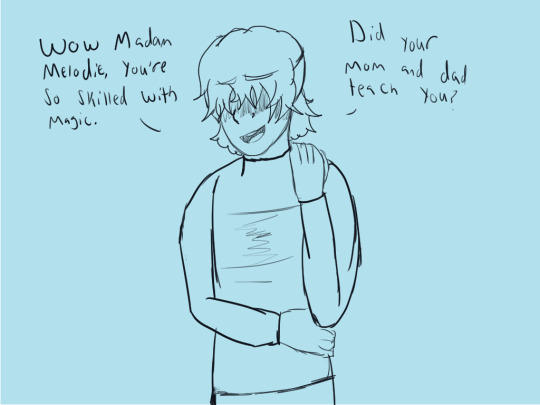


Oh what a happy family i'm sure Melodie had a happy and stable life and parents :)
#hi everyone first post on here#i drew this and im shaking bc i cant show my party yet#so i made this secret blog so you guys can witness my sins#anyways fuck trent ikithon all my friends hate trent ikithon#explorer's guide to wildemount#wildemount campaign#wildemount#exandria#dnd#dungeons and dragons#dnd art#dnd 5e#trent ikithon#Anastasia Murett#Melodie Ikithon#critical role campaign#critical role#how the fuck do i tag this since its my actual campaign#but anyways hi everyone#dungeon master#5e#dnd campaign#my art#art
1 note
·
View note
Text
D&D 5e's alignment trap
The 5e alignment system is a useful shorthand and a misleading trap. The Outer Planes as presented in the 2014 Player’s Handbook and Dungeon Master’s Guide only make the alignment system’s problems worse. The perfect overlap between alignments and planes—and the total lack of alternative Outer Planes—reinforces the alignment system’s worst inclinations: easy stereotyping, reductionist thinking,…
View On WordPress
#5e#afterlife#alignment#D&D#DnD#Dungeon Master&039;s Guide#Dungeons & Dragons#dungeons and dragons#fantasy#morality#Outer Planes#planes#Player&039;s Handbook#reductionist#roleplaying games#RPGs#stereotyping#Worldbuilding
0 notes
Text




So, what do we do with that coin that says live or die? We flip it for death saves! In our home game we thought dying in D&D wasn't exciting enough so we altered the odds. The chance of survival is greater in 5e than the chance of dying. Too scared to flip that coin? No worries, you can get up with 1 HP! You'll have to roll on the injury table in the Dungeon Master's guide in order to get that precious hit point back. You can do so up to a maximum equal to your constitution modifier, with a minimum of 1.
In our game you can also mark off one of those uses to negate the effects of a critical hit, but must once again roll on the injury table.
Our poor artificer lost a leg 2 sessions ago! Luckily he can tinker himself a new one. If that'd happen to my monk? She'd likely need to retire. Nonetheless i like the storytelling opportunities it provides!
134 notes
·
View notes
Text
D&D 3e is an interesting edition in the context of D&D's greater history because it very much set D&D on its current course: it was the first edition of D&D to utilize the d20 system (where most actions are resolved via the roll of a d20 + modifiers trying to beat target numbers of ever-increasing difficulty) and it was the first edition of the game under Wizards of the Coast, and in many ways D&D 5e is specifically a throwback to D&D 3e. Sort of.
You see, the thing that sets D&D 3e apart from the other sundry versions of D&D, including its more similar than people are willing to acknowledge Wizards of the Coast sisters 4e and 5e, is that it's a rather complex game. This is something it has a reputation for, and it stands out as the most complex edition of D&D even when set against its other complicated siblings. Most discussions of said complexity, however, focus mostly on characters, which is understandable, because characters are the main way in which players will end up interacting with the game. And on a purely character-based level the game already is more complex than any other edition of D&D: players need to worry about feats (which are more plentiful than in 5e and require keeping track of more variables than in 4e), class features (some of which can be so complex as to mandate keeping track of a whole other character), spells, skills (which need to be bought in ranks: none of that "skilled" or "proficient" binary, skills are increased one point at a time), and whatever else. But there's more.
And that stuff is why I say that 5e is only "sort of" a successor to D&D 3e. It is a successor to D&D 3e in the sense that D&D 3e is the edition of the game it's most structurally similar to: characters consist of more or less the same parts as they did in D&D 3e, but there's often more gradation and fewer discrete choices between those parts. But when it comes to the actual philosophy of gameplay, D&D 5e is a lot more similar to 4e than most people are willing to admit.
Which is weird, because on a superficial level D&D 5e is a rejection of many things that informed D&D 4e's design. D&D 5e characters don't have any of the same "stuff" that D&D 4e characters have, so they must be different, right? Well, there's that focus on characters again. Because D&D 3e's design is about much more than just the way characters are built. D&D 3e is the closest thing that D&D has ever had to a physics engine (it's a really bad physics engine that doesn't really simulate anything beyond D&D 3e, but it is there). It's a game where plausibly every interaction in the fiction of the game could be run through the game's system to get a consistent result. D&D 3e is a game that gives you the DC of a Balance check to run parallel to the peak of a roof on an angled roof. It's DC 15.
This type of maximalist game design has really only been present in D&D twice: first in the Dungeon Master's Guide for the first edition of Advanced Dungeons & Dragons, which was the greatest example of Gary Gygax off his shits ever produced, and then again in D&D 3e. And 3e took it to unprecedented levels, because even though the AD&D 1e DMG was full of weirdly specific rules it never got to the same level as 3e. And even though D&D 5e is superficially taking after 3e (mostly in a "look we made the 4e go away so the game is good again right?" type of way) it is at the end of the day a completely different type of game.
Anyway D&D 4e and 5e both run on 3e's code but are both doing their own things on it, and D&D 3e kinda sucks but as a thing that exists it kind of represents this strange dream of a game that wasn't quite there. A hard systemic tabletop dungeon crawler with all the Stuff you know from Dungeons & Dragons but running on a sleeker code. There is a reason why D&D 4e abandoned 3e's maximalist design and why 5e didn't adopt it again beyond superficial similarities: D&D 3e had also, by design, turned D&D into a game of fair combat encounters, and while there were some callbacks to AD&D 1e's laissez faire design (where a level 1 party could run into instant death killer bees: 3e put back those encounter tables but heavily curated the capabilities of low level monsters to make sure that one-shotting player characters wouldn't be so commonplace), D&D was now forevermore a different type of game. A game where the goal was for characters to be able to take a certain number of combat encounters each day and expect to survive. And hey, of all of WotC's three editions of D&D, at least D&D 4e sort of accomplished that goal!
But yeah, D&D 3e was designed as a systemic game with multiple interlocking parts that was actually kind of stupid as a system but one could still extract varying quantities of fun out of it through system mastery, but because a lot of those interlocking parts were kind of unnecessary for the sake of what most people wanted out of the game successive editions wouldn't follow that design. But it makes one think: what would a new edition of D&D that had maintained that desire for systemic design and simply polished it up and made it actually not bad have looked like? Probably not like Pathfinder 1e, sorry Pathfinder fans but Pathfinder isn't exactly an evolution of D&D 3e's design philosophy as much as it is simply doing all the same stuff and fudging some numbers.
122 notes
·
View notes
Text
psst. spawn batstarion enjoyers
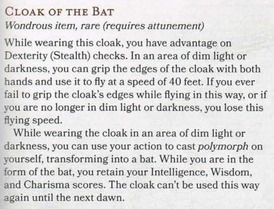
found this item in the 5E Dungeon Master's Guide that may be of interest to y'all
#bg3#astarion#batstarion#i won't lie i am imagining astarion flying with the cape. holding it in his hands all dramatic. making me laugh a wee bit
408 notes
·
View notes
Text
5e Villain Arc 8
Hey, it's been a while. I was really depressed and broke for a while, and now I am less depressed and in process of being less broke.
Unlike many people who manifest their depression into anger, my anger is the righteous authority of my positive outlook on life. The happier I am, the angrier I am. Happy, at least on a scale of of "uwu sad boi" and "maybe I am not a complete failure." Basically when I'm not a sad boi, I remember that, "you know what, I WAS right all along, I was just too sad to notice it." That's why I then get angry because I feel that my sadness made me capitulate to things I never would have, otherwise.
Anyway, this Villain Arc is about the Bard
The Bard is actually ridiculous. Who fucking thought that this Class made sense. Now, granted, the Bard Class has always been, in my opinion, a bit unessesary. Much of what gives the Bard their identity is not actually that unique: the ability to play/perform music. Any Character can pick up an instrument and learn to sing in most editions of D&D, so the Bard doesn't really have a sole ownership to the "musician" role.
The Bard, instead, is designed to be a "Jack of all Trades, Master of None" Class. Which I do enjoy. Despite my previous statement that they are "unesseasary," I do think Bards are fun and interesting. I have played Bards several times in AD&D 2nd and have found them to be consistent contributers to the adventure. Combining elements from Villain Arcs 4 and 7, an important thing to note about Bards in earlier editions is that they are required to have decent Charisma (15). This means that they will have access to more henchmen than most Characters besides a Paladin (if anyone ever got to be a Paladin) and the Enchanter Specialst Wizard. Henchman are good for reasons stated below. Playing a Bard, you always feel like you are contributing, but that there is someone else in the party who is better than you at whatever you are trying to do. And that's okay. A lot of the time, the party really needs two people doing similar things to solve a problem. More fireball never hurt anybody. They also have the ability to buff Characters around them, and this becomes a staple feature that makes them unique.
The Bard makes a lot of sense in AD&D 2nd in particular because of how Multiclassing works. You could be a half-elf Wizard, Thief, Fighter and approximate a Bard, or you can just be a bard for 1/3 the EXP requirements (it's complicated) and gain some unique features as an upside. And if you are a human, Bard is about the only place for you to be that sort of a multiclass (humans cannot multiclass, only Dual-Class which is different). I could write up a full "how to play guide" for the AD&D 2nd Bard, but I won't. It is worth noting how weird the Bard was in AD&D (1st Edition). If you don't know, you should look it up. Interesting ideas, but ultimately pretty weird.
The point here is that 2nd Edition did a pretty good job defining what a Bard would be. They can do everything (besides heal), and they have a special niche with Charisma and Music, but they are balanced by a lack of potency. 3.5 follows this up with a pretty straightforward adaptation of the Bard. It is exactly what you imagine a Bard would be from 2nd to 3rd. My biggest gripe with the 3.5 Bard is that they get access to healing magic. This breaks a pretty fine balance of spheres of influence on the game that I think the Bard, as a class with a certain identity, can never recover from. Since, obvioulsy, the Bard has spent more time being able to heal than they haven't, it might be reasonable to believe that Bards SHOULD be able to heal. After all, they are a support class! Support = heal! This is a capitulation to video game-logic that I find to be dull and unimaginative. Fitting Dungeons and Dragons, and tabletop roleplaying games, into the framework of DPS, Support, Tank, the baseline archetypes of Roles in many competitive and roleplaying video games, is concerning. While there are parallels, because these video games are often inspired, in some form or another, from D&D, these are not accurate ideas about how a game actually works. The fundamental assumption of designing the game to function in this way is that combat is the default nature of engaging with the world, and this is simply not true in tabletop games. Players have the agency to approach problems however they wish using whatever resources they have access to. Placing Bards into the basket of "support" strips them of their unique identity as "Bards."
This is my biggest critique of 4th Edition. This is a bit of an aside, but I promise we'll get back to the subject soon. It is relavent.
I don't hate 4th Edition.
I am not 4th Edition's #1 hater.
I would rather player 4th Edition than Hasbro's: Wizard's of the Coast's: Dungneons and Dragons (2014 or 2024).
However, 4th Edition is the most "a video game" of a TTRPG in the entire D&D catalogue. That does not make it a "bad" game. I think that much of the actual design of 4th Edition is pretty good at fascilitating the kind of gameplay it is going for. I just don't like that kind of game. And the primary issue is the the four "Roles" system: Stiker, Defender, Controller, Leader. To their credit, it is not the MMO three role system: DPS, Tank, Support, so at least they were being unique within the framework. However, placing the classes like the Bard into the same category as the Cleric is kind of the kiss of death for the Bard, in my opinion. The Bard is no longer an economy multi-class single-class, they are support character through-and-through (with even more emphasis on healing).
Okay, back to Hasbro's: Wizard's of the Coast's: Dungeons and Dragons (2014). As with many elements of this game, Hasbro's: Wizard's of the Coast's: Dungeons and Dragons (2014) took most of its game design philosophy for the Bard from its 3.5 itteration. It is back to being an economy multi-class Class with unique upside. As per the usual (see my other villain arcs), this comes with many instances of jank.
5e Jank That Applies to the Bard
Dexterity: Well well well, if it isn't a returning villain from Villain Arc 4. That's right, Dexterity is one of the primary attributes of the Bard. How cool and exciting. They are ever so slightly throttled by not getting access to longbows immediately, but being an elf should patch that up (with a bonus to Dexterity!)
Charisma Good: Charisma has always been "good" or at least better than expected in most editions of D&D. Being able to influence NPCs is pretty incredible. However, with the shift to so many casters being Charisma-based, it means that min-maxing your Bard is actually very easy (to clarify, this point is about how in older editions, Bards needed to actually have to spread out their Ability Scores to get the most benefit from their full kit).
Skills Nerfed: Characters, on average, have way less access to Skills in 5e than they used to in older editions. These were also gated behind Intellignce as the bouncer to get in. However, the Bard does not really have to contend with that. It gets the second-most number of Skills off the bat (as if they had a good intelligence score in earlier games), and they get half-proficiency to all other skills they are not proficient in, IN ADDITION to: "Your proficiency is doubled for any ability check you make that uses either of the chosen proficiencies," Expertise.
HP Buffs: The fighter gets to keep their 1d10, but the Bard now gets 1d8. Cool. This means that, on average, a Bard with equal Constitution will have two fewer HP at 1st level and 1 fewer at every level thereafter than a fighter.
Full Caster: The Bard is now a full caster. Sweet jesus.
This all mixes into a perfect storm that makes the Bard an exceptional base-line Class. It gets passive bonuses to its Ability Score-potency relative to the Martials, Clerics, and Druids in all the major categories.
We have talked to length about Dexterity, however I cannot stress how much the bard benefits from the buffs to dexterity in combination with bounded accuracey. The Rapier is a frankly stupid weapon that makes me extremely frustrated both to use and have used against me. It's not medieval, it's actually quite heavy, it's really bad at combating armor, etc etc. S-tier weapon in 5e. There is basically no reason to ever use a longsword. I am amazed that they bothered to only give the Bard access to Hand Crossbows. Anyway, all this together means that, at level 1, the Bard is not considerably worse than the Martials at combat. In fact, they are basically equivalent. Because Carrying Capacity is the way it is, there is no reason to invest into Strength. Ever. Actually, the Bard might be better in combat than a Martial becuase Dexterity factors into Initiative and Strength doesn't.
This game, as well as the Bard in particular, completely cheats the reasons to have a high Intelligence score in other editions. About the Skills in 5e, a clever reader might tell me, "WEL AKSHUALLY, the bard in 3.5 gets 6 Skill Points every level compared to the Rogue's 8 Skill Points, so it is the same ratio!" Okay, now tell me where Jack of All Trades is in the 3.5 Core Guidebook. Where in the Bard section of 3.5 is the feature that gives them bonuses to every skill in addition to that 6 every level? In 3.5-terms, this is like giving the bard 6 + Int (standard) + A BUNCH for free. Exactly what this number is is not worth calculating, but it is more than 2 relative to 8. The result of this is that the Bard is passively benefiting from a high Intelligence as it factored into past games that other classes did not recieve. This is kind of a wonky argument, but I stand by it.
I can see impriving the Rogue's HP. I think the Rogue might be the only class to deserve a bigger hit-die. Why does the Bard get a bonus +2 to Consitution pre-built into their Character? Fucking ridiculous.
Making the Bard a full caster still absolutely baffles me. They get rougue-adjacent (and/or better) skill allocation, they get near-martial level of combat, and they get Wizard Level combination of power and utility in spells. The Bard has the second-best spell-list in the game, and this is supplemented by them being able to pick Spells outside their List with Magical Sectrets. Yes, it loses out on some DPS staples like Lightning Bolt and Fireball, but it makes up for this in still having decent damage spells, HEALING, and utility. Utility spells are really the engine behind reddit cheese strats, and the Bard gets access to basically all of them. Viscious Mokery is a really potent Cantrip for both being able to do damage and throttle most martial enemies at the same time. I hate Viscious Mockery memes so much.
The Result
This is not including all the Bard-specific features that they can provide a party that no one else can. Bardic Inspiration is pretty essential in a game with bounded accuracey as one of the few ways to actually make number go up without instead giving yourself Advantage. Song of Rest is pretty great at low level. The Bard is the best Class in the game, although it does not have the best Archetypes (although they are pretty good). Specifically, being a full caster and getting Extra Attack at 6th Level, while I think is just fundamentally worse than the Lore Bard, is really insulting to Martials. Consider the Beast Master Ranger and the War Bard. What the hell? Also, consider giving the Bard the Moon Druid Archetype. It would clearly be the best Class/Archetype combination in the game, in my opinion. The Moon Druid is, frankly, only held down by its Class being an otherwise okay, full-caster. The Bard has the best overall, average numbers in the game, all things considered.
The Bard being extremely potent means that you are going to see them a lot while playing the game at different tables. I have heard it said that "every party needs a Bard." And god fucking damnit do I hate playing with Bards. Something about being a Bard turns players into the most obnoxious, anti-social, evil gremlins in the world. It's miserable, and it makes playing and running the game a fucking nightmare when everything anyone does is retorted by another fucking quip and a 3-minute jam-session to "oh, this reminds of this song." You liking music is not a personality trait. I'm sorry. That's like saying "needing to eat food" is a personality trait. That's not unique. You liking music is not fundamentally unique or interesting. You are not fundamentally unique or interesting for playing a Bard in Hasbro's: Wizard's of the Coast's: Dungeons and Dragons (2014). You are a power-gamer masquerading as a "roleplay over rollplay" dipshit who waists the time of everyone at the table with your shitty middle-school improv horny-evil fanfic nonsense. And I am tired of the game that promotes the most obnoxious style of play to be front and center because it is attached to the best Class in that game.
----EDIT-----
AND THEY FORCE THEMSELVES INTO THE FRONT OF ALL OF THE ROLEPLAYING. Even out of combat, the Bard is the only one that really gets to play the fucking game. "You should really let me talk to the priest, I have a high Charisma and Charm ^-^ ."
You see, older editions of Bards were actually quite difficult to play. Both during creation and in-session, a Bard-Chararcter is an interesting challenge to balance around the specific pattern of the party. The Bard can fill in multiple gaps the party has or double-over a few specializations when needed. However, this was always difficult and risky because your stats and features were not concentrated to support being good at all those things. You had to be smart and pay attention to when you need to transition from one mode of play to another. The Bard, truly, was a support character for the party. Rarely ever the main character but very useful in many situations (especially for small parties). Now, the Bard can solo an entire campaign by themselves. They can do everything. They do not need help. Anything another Character could provide can better be handled by the Bard with a Scroll or an NPC that is fiercly loyal to the Bard due to either magic or Charm.
Here is my take. I think everyone is playing Bard wrong. I think that optimal Bard performance is Dex + Con. What do you use Charisma for? Spell DCs and Spell Attacks? Hear me out, just don't cast Spells that require saves against monsters that you think are good at those saves and get a bunch more HP instead. Like I've said before about Cantrips: just fucking look at the monster and guess. Bonus to hit isn't even that important because of bounded accuracey. If you plan on using Charisma Skills, just use your "Your proficiency is doubled for any ability check you make that uses either of the chosen proficiencies," Expertise on those Skills. Like, you really don't need Charisma that badly. I mean, you might as well go 8, 15, 15, 8, 8, 15 oonga boonga because it's not like Charisma is hurting you either. I would probably rather go 8, 15, 15, 8, 15, 8 and get a "Your proficiency is doubled for any ability check you make that uses either of the chosen proficiencies," Expertise in Perception and use my spellcasting entirely for healing and support. Yes, I think Perception is more valuable than attack modifiers to spells. Why are you attacking? Just turn invisible and teleport and caste haste (Additional Magical Secrets at 6th level). EZ. Perhaps Hill Dwarf is the optimal Bard build because it boosts con and wis. 8, 14, 15, 8, 14, remainder Hill Dwarf bard. This is a joke, obviously Stout is the best because +2 DEX LET'S GO 8, 14, 14, 8, 15, remainder stout halfling. SO MANY CHOICES I LOVE THIS GAME EVERY CHARACTER IS VERY UNIQUE AND MECHANICALLY DIVERSE.
Previous Villain Arc
12 notes
·
View notes
Text
(Almost) every single canon adventure for dnd 5e in order for @doodl3 and any other adventure that happens to stumble upon these
Lost Mine of Phandelver (the adventure the book The Shattered Obelisk is based off of and is the starter set for 5e) Hoard of the Dragon Queen (The first official adventure for 5e) Rise of Tiamat(The Sequel to Hoard of the Dragon Queen) Princes of the Apocalypse Out of the Abyss (for Undertale fans this is going to be the closest you'll get to Undertale Dnd or at the very least Deltarune) Curse of Strahd Storm King's Thunder Tales From The Yawning Portal (this is the first dnd book to feature multiple dnd adventures from the past modified for 5e with the adventures in order being (The Sunless Citadel, The Forge of Fury, The Hidden Shrine of Tamoachan, White Plume Mountain, Dead in Thay, Against the Giants and The original Tomb of Horrors) Tomb of Annihilation (this one is a bit like Legend of Zelda sorry for the quality this was the best one I could find) Waterdeep Dragon Heist Waterdeep: Dungeon of the Mad Mage (like Rise of Tiamat this is the sequel to Dragon Heist) Ghosts of Saltmarsh (for those fans of Pirates of the Caribbean this one is for you like Yawning Portal this is yet another mashup of past dnd adventures modified for 5e those adventures being: The Sinister Secret of Saltmarsh, Danger at Dunwater, Salvage Operation, Isle of the Abbey, The Final Enemy, Tammeraut's Fate and The Styes) Dragon of Icespire Peak (the second of the 3 starter sets) Baldur's Gate - Descent into Avernus Icewind Dale - Rime of the Frostmaiden Candlekeep Mysteries (this is a set of mini adventures :D) The Wild Beyond the Witchlight (if you love Satyrs you'll love this one) Journeys through the Radiant Citadel (Another set of mini adventures :D) Dragons of Stormwreck Isle (the final starter set for 5e) Keys From The Golden Vault (yet again another set of mini adventures :D) Chains of Asmodeus (Here's a little fun fact about this adventure even though it's centered around the Nine Hells this book was used for charity where half of the proceeds made by this book were donated to charity :D) Quests-From-the-Infinite-Staircase (The final adventure for Dnd 5e this one is yet another set of past adventures reformated for the rules of 5e these ones are The Lost City, When a Star Falls, Beyond the Crystal Caves, Pharaoh, The Lost Caverns of Tsojcanth and Expedition to the Barrier Peaks)
Sorry I couldn't find The Shattered Obelisk, Vecna: Eve of Ruin or (the final set of past dnd adventures reformated for 5e)
In these books you will also find maps, stories, monsters and unique magic items that aren't in any of the other books (Don't worry they give descriptions on what the magic items do and they even provide monster stat blocks)
To @doodl3 and any other adventurer who stumbles upon these please enjoy these books. 5e has been almost my entire life and these books have always made me so happy. I am sad to see 5e go next month (as of me typing this). But with these pdfs you can now view the adventures I've been on and replay them as you wish. To any who see this may these stories inspire you to write epic stories and as I always say: May your dice roles be legendary. Whoever reads this and reads all of these books 1 you are awesome VIRTUAL FIST BUMP FROM ME. 2 please tell me which of these books you enjoyed :D.
Oh ps you'll need the Player's Handbook, Dungeon Master's Guide and Monster Manual to read these books.
29 notes
·
View notes
Text

Astral Plane
Art for Dungeon Master's Guide 5e
Art by Aleksi Briclot
56 notes
·
View notes
Text
Descent into Avernus and Why You Should Read It.

(Or, like, at least skim!)
Descent into Avernus is the D&D 5E module describing the events that took place just before the timeline of Baldur's Gate 3 picks up — including more information and context for the ordeals undergone by the tiefling refugees.
The module is described as "complimentary [sic.] to the story of Baldur's Gate III", and the studio itself made a point to note that they "worked with Adam Lee, one of the lead writers of Descent Into Avernus, when crafting the story of Baldur's Gate III."¹
The section I would most strongly recommend taking a look at concerns the city and citizens of Baldur's Gate itself, the "Baldur's Gate Gazetteer", spanning from pages 158 to 215.
Included here are things like:
A stat block and bio for Nine-Fingers Keene (although, sadly, nothing on just what she has going on with Jaheira–).
Further information on Dukes Ravengard and Stelmane.
A full map of the city, and subsequent sections giving details of each region.
A section on Ramazith's Tower, and its current master, Lorroakan.
Details on a variety of named and well-described businesses.
Further clarifying information on exactly what is going on with Wyll's new horns.
I'll work on making some individual posts in the coming days delving into these aspects and more, but if you'd rather not wait around for that for all your worldbuilding and storytelling needs, go forth with my blessing, and this handy guide² to an accessible copy:
[Keyword Search Terms: "Descent Into Avernus" + "Anyflip"]

¹ Christian Hoffer. "Dungeons & Dragons Clarifies Relationship Between Descent Into Avernus and Baldur's Gate III". June 2019. comicbook.com.
² I tried to include the link with the original attempt at this post, but the Tumblr tag index did not like that. I hope this alternative suffices.
#voidling speaks#meta#my meta#bg3#descent into avernus#baldur's gate#resources#nine fingers keene#lorroakan#jaheira#wyll ravengard#if you saw the original i am not planning to delete it at this time#but hoping that this alternative appeases the unknowable tag indexing monolith
54 notes
·
View notes
Note
I usualy agree with your anti-DND posts, but I don't think it's fair to say that 5e doesn't provide ANY guidance for GM-ing. The Dungeon Master's Guide is entirely advice on how to run DND 5e, including clear rules on how to determine the dc of diplomacy checks, when you explicitly called any non-combat mechanic arbitrarily decided.
There's plenty to criticize in 5e already, and the DMG is far from perfect, so there's no need to ignore a core rulebook entirely to prove a point
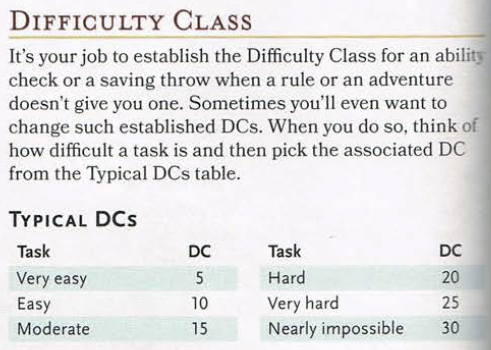
i do not think this is very good guidance
125 notes
·
View notes
Text
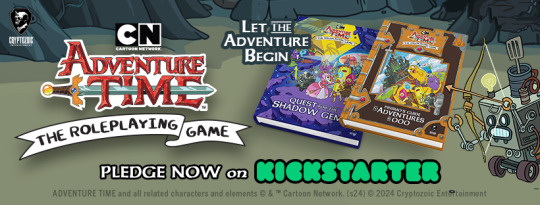
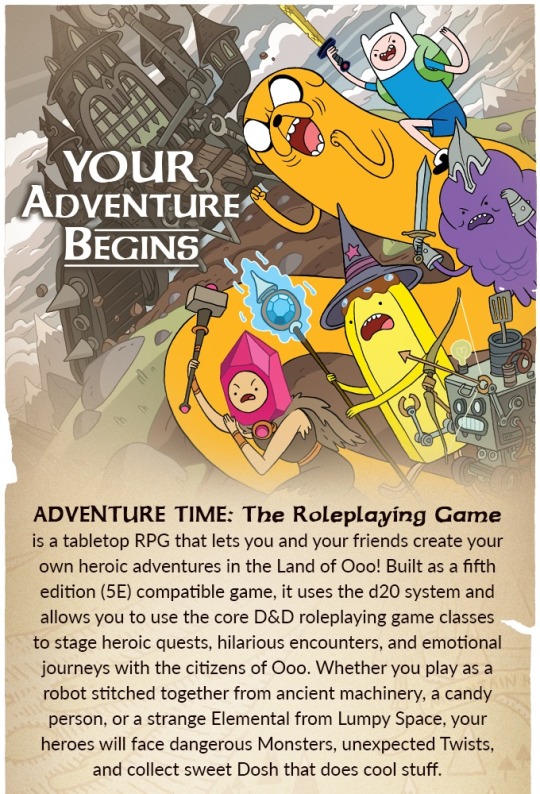

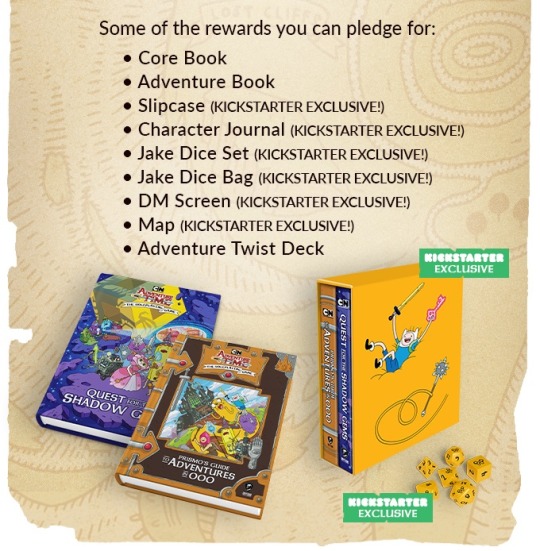

If you’re not familiar with 5E rules, don’t worry! Roleplaying games are about letting your imagination run wild as you create your own characters and stories. The rules provide support for your imagination and structure for your hero, but take a back seat to the FUN play at the table.
For those new to roleplaying games entirely, we are providing Jake’s Shmowzow Guide to Roleplaying Games with every copy of the Core Book exclusively on Kickstarter. It’s a simple guide to get any person started having fun with the Adventure Time RPG. Written by Ray Winninger, co-designer of the DC Heroes RPG and former Executive Producer of Dungeons & Dragons, the guide includes the needed core rules from the 5E OGL, a simple step-by-step explanation of the simple ideas you need to understand to begin play, and finally a walk-through of the character creation process. All guided by Jake!
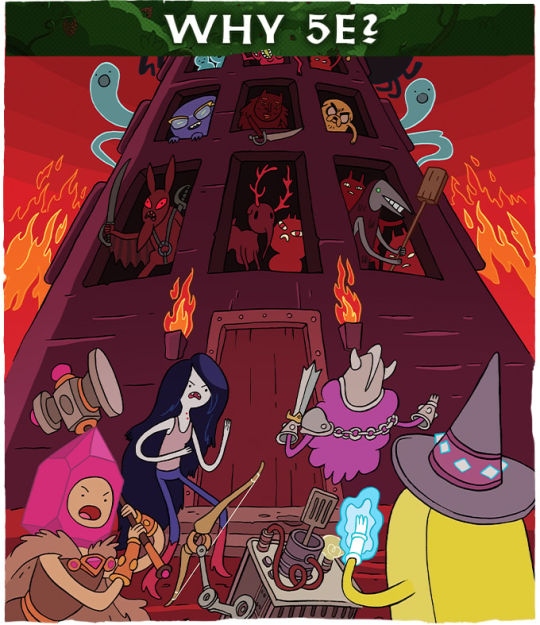
Adventure Time has its roots in the older editions of Dungeons & Dragons, with episodes and story arcs that grew from the pastiche fantasy adventure that the second and third editions laid out so beautifully. We believe that the high-quality design of 5E—and its very nature—are well-suited to capturing the open-ended excitement and sense of wonder that are at the core of Adventure Time. If Dungeons & Dragons gave birth to Adventure Time, using 5E for Adventure Time: The Roleplaying Game brings everything full circle and is true to the spirit of the series.
We believe that we can craft and implement the world of Ooo and the features of the Adventure Time RPG best in 5E, empowering you with the feeling that you can be any person you want to be and that anything can happen when you step out your door for adventure!


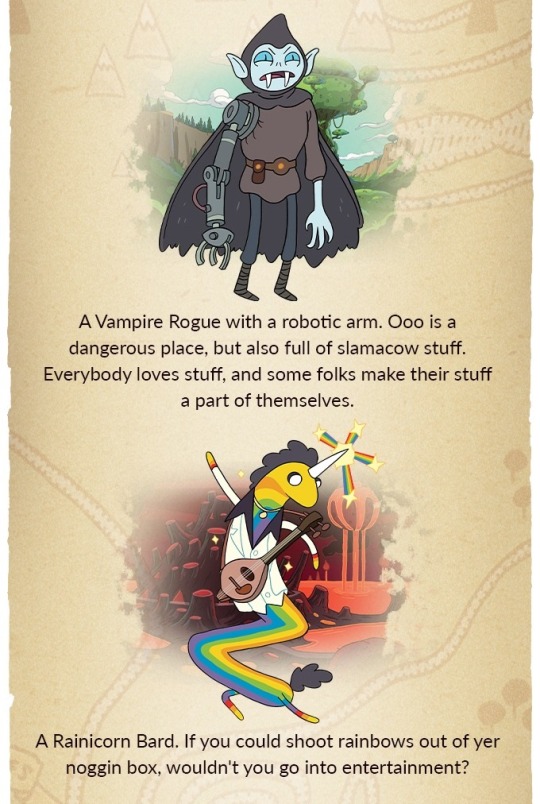
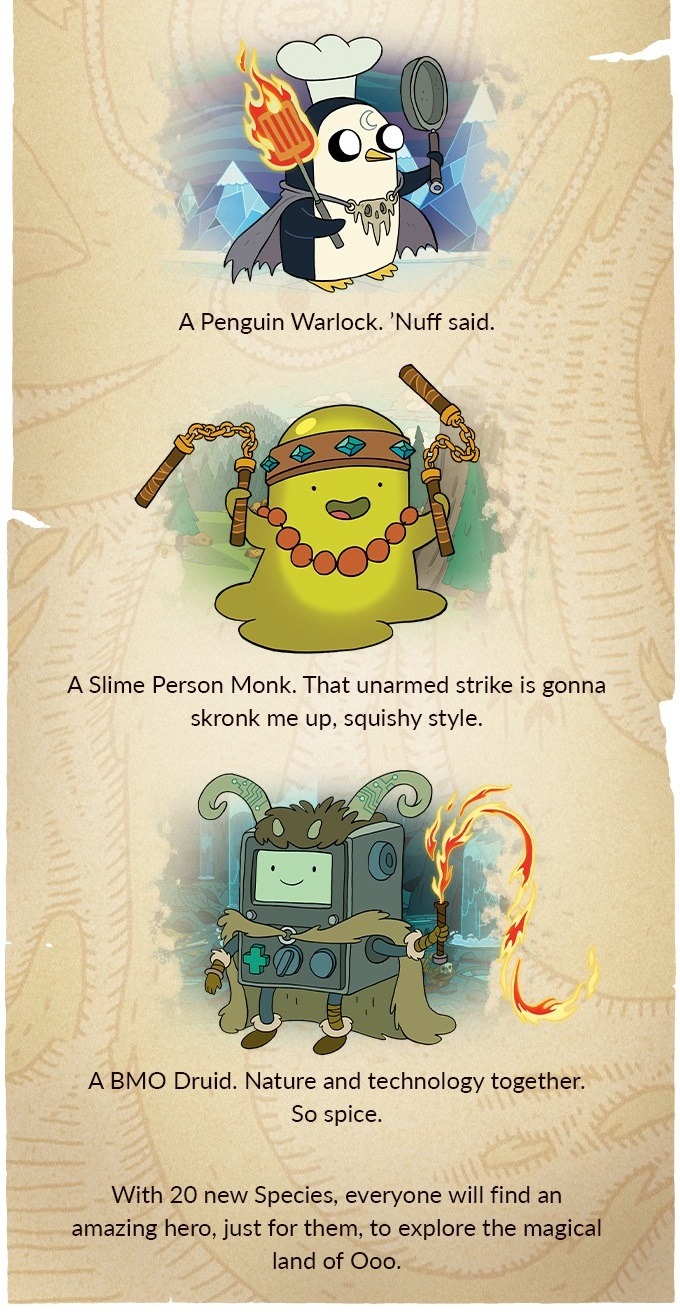

But how, exactly, do you explore Ooo? This is a tabletop roleplaying game built using the Dungeons & Dragons rules, basically. In fact, if you are familiar with those rules, you already know all about how to play Adventure Time: The Roleplaying Game.
If you’re not familiar with those rules, you don’t need to worry. Dungeons & Dragons is a game about letting your imagination run wild; it is a game that is played through conversation, is moderated by dice, and takes place in your cranial. As you adventure through the amazing land of Ooo, stuff will happen. There is a player, called the Dungeon Master, who will tell you about that stuff.
As a brave adventurer, you will want to respond to your Dungeon Master with awesome heroic actions. Your character will have a set of attributes and some skills and powers that provide options for those reactions. But you can respond however a person could respond (if that person was a Wildberry Person, with an axe!). However you respond, you will tell the Dungeon Master what you want to do.
Once you choose your action, it’s time to get mathematical with it. You will roll a twenty-sided die and add a bonus number to it, based on the attribute (or skill or power) that is most applicable to the action. If the total number is high enough to equal or exceed a target set by the Dungeon Master, you will succeed, and the skill or power will dictate the results of that action.
And that's all there is to it! Imagine what the Dungeon Master tells you, have a conversation with the Dungeon Master about what you want to do, and roll a twenty-sided die to see if it works. Three simple steps to exploring (and loving!) the Land of Ooo.
And we’ve got some sweet new mechanics to enhance your awesome RPG experience and fill it with Adventure Time!


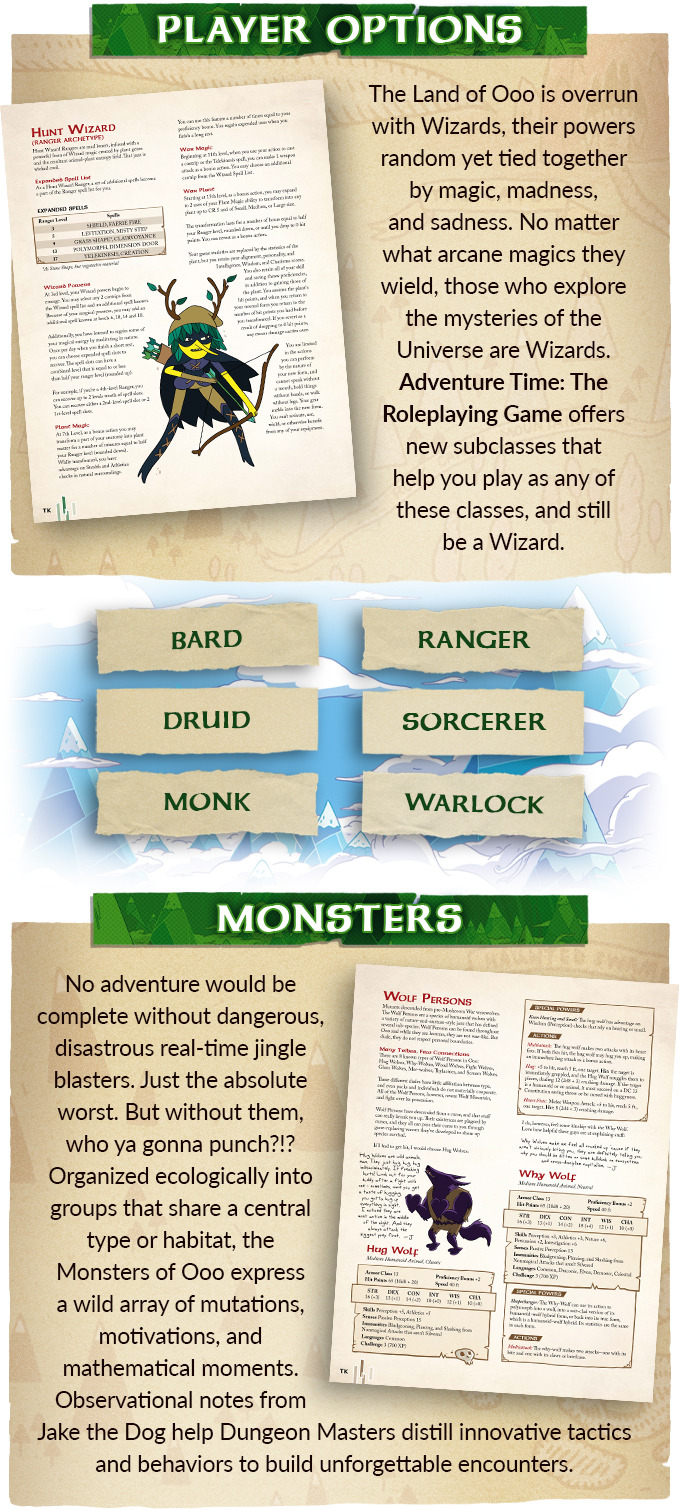

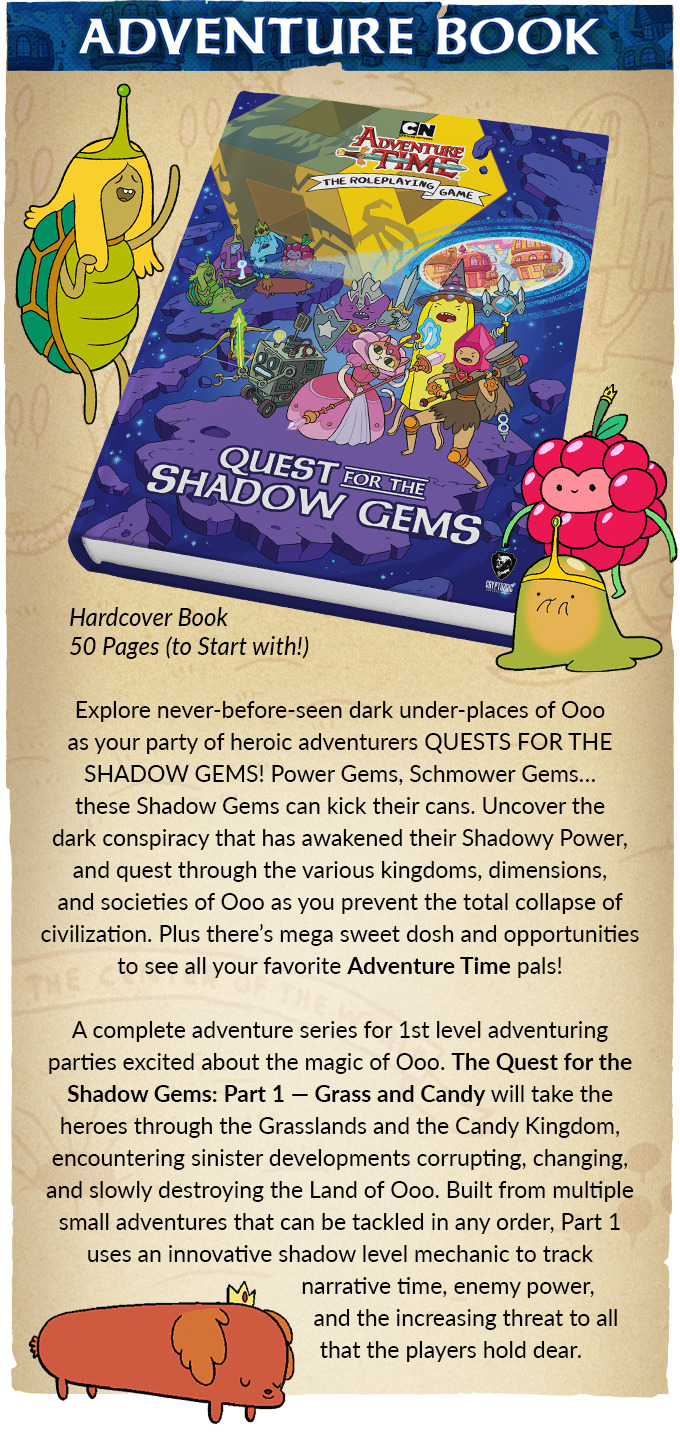
Kickstarter campaign ends: Wed, May 15 2024 8:00 PM BST
Website: [Cryptozoic Entertainment] [facebook] [twitter] [instagram]
38 notes
·
View notes
Note
What’s the ideal D&D 5e campaign? Like, what kinds of games take advantage of & play into the assumptions 5e makes (maybe even to the point where 5e is the best system for this game)? Thank you. :)
Now that last part is a tall order, because the researchers here at Vixen Studies Rules have not yet devised a type of D&D that isn't better played with some other edition of the game.
But as with any edition of the game, I think one is best served by assuming the Wargaming Stance. This is not a game of plot and character arcs. This is not improvisational theatre. This is a game of weirdoes entering dark and dangerous places for glory and riches.
But the Wargaming Stance isn't only about crawling through dungeons deep, it's also about character progression. That's ultimately what the game is about: getting more powerful. And this doesn't just mean getting more spells and abilities, no, it means also the accruing of temporal political power. The bastion system from the 2024 Dungeon Master's Guide brings strongholds back into play, so there is now support for an anchor that ties characters into the world.
It's super late and I'm having trouble keeping my eyes open so I'll just summarise: aim for gold and glory, accrue power, don't make the campaign hinge on the survival of any of the player characters. Crawl through dungeons and the wilderness. Build a cool castle. Raise armies and take on your political rivals. That's what D&D is all about. No plot, just adventure.
7 notes
·
View notes
Text
Calling For D&D Players of All Experience Levels
Hey all! I am a dungeon master in the US eastern time zone looking to run a D&D 5e game Tuesdays or Saturdays. Saturdays could be at any time, but Tuesdays would be no earlier than 4pm EST. I would be comfortable running a game for up to six or seven players, with there being none as of the making of this post. Level of experience doesn’t matter! If you’re a veteran you’ll fit right in, but if you’re just starting out in the hobby this can be a gentle and friendly guide to help you out!
As for setting, I’m flexible. I can do a pre-established one like Faerun or Exandria, but I also have a homebrew setting I’ve named Aetherius and have been developing for a few years now! I even have a World Anvil here (basically a Wikipedia page)! As for story I have plenty of modules to choose from or can craft one myself :)
Themes can be expansive, ranging from the hilarious to the dire, and I can be flexible in mixing and matching such things. I’m also a very “rule of fun” DM: whatever facilitates the most authentic fun at the table is what goes. Sometimes that’s rules as written, rules as intended, rule of cool, or all of the above.
I’m generally also looking to explore the new rules, especially the bastion system, which I already have and can share a load of content with players!
In Summary:
Rule Set: D&D 5e
Time Zone: US EST
Themes: Depends on players and their wants
Setting: Established or homebrew
Story: Module or homebrew
Experience Level: Inconsequential
Number Open Slots as of this Posting: 7
11 notes
·
View notes
Text
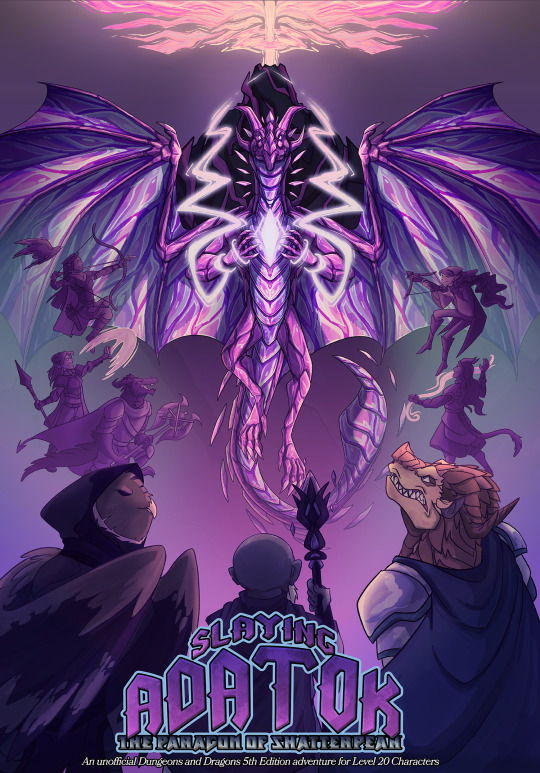
Slaying Adatok: The Paragon of Shatterpeak, is available now for free!
"Slaying Adatok: The Paragon of Shatterpeak" is an unofficial dragon-slaying Dungeons and Dragons 5e adventure for Level 20 players. Players will venture into 4 unique lairs where they will de-power The Barrier protecting the peak of Shatterpeak Mountain. Once they climb to the mountain's top, they will get to face off with Adatok the Paragon, the Amethyst Greatwyrm.
This adventure includes a two pdfs (one normal and one print-friendly), battlemaps and art for each of the 7 unique locations and custom tokens for every named monster and NPC. As a Dungeon Master you shouldn't have to do any extra legwork to find assets to play your adventure!
This adventure assumes that you own the following sourcebooks.
Fizban's Treasury of Dragons
Dungeon Master's Guide
Player's Handbook
Monster Manual
Xanathar's Guide to Everything
If you played this adventure, please tag me on social media (@AshMcGivern) and let me know how it went. If you enjoyed it, consider leaving a tip! Either way thank you so much for playing!
Download it here from Ko-Fi!
#dungeons and dragons#dragons#dnd5e#Slaying Adatok#ITS HEEEERE!!!!#cant wait for people to play it#please def let me know how it goes id be SO stoked to hear about it#adapt it to pathfinder!! see if I care!!!#it uses 5e statblocks but im sure you can find other monsters in other systems to substitute!!!
21 notes
·
View notes